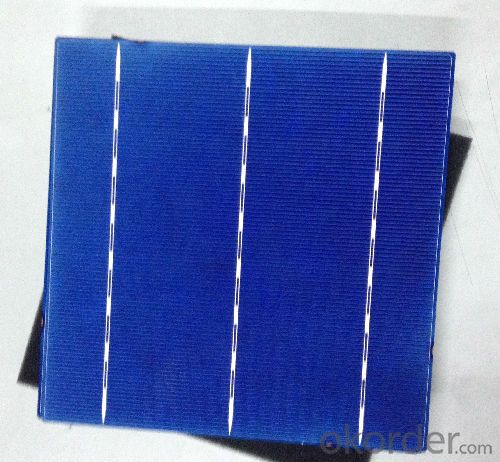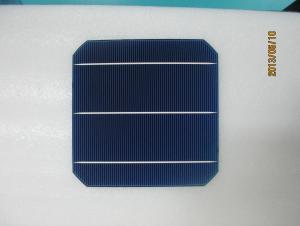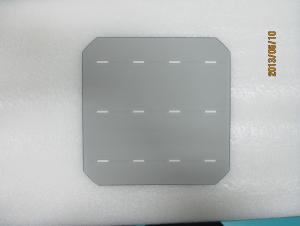156*156MM MONOCRYSTAL SOLAR CELL WITH HIGH EFFICIENCY
- Loading Port:
- Shanghai
- Payment Terms:
- TT or LC
- Min Order Qty:
- 1000 PCS
- Supply Capability:
- 20000000 PCS/month
OKorder Service Pledge
OKorder Financial Service
You Might Also Like
HIGH EFFICIENCY MONOCRYSTAL SOLAR CELL (156*156MM)
Product Description:
Format: 156mmX15mm + 0.5mm
Thickness: 210 mm ±40 mm
Front (-): 1.5mm bus bars (silver),blue anti-reflection coating (silicon nitride)
Back (+): 2.5mm wide soldering pads (silver) back surface field (aluminum)
Efficiency (%) | Pmpp (W) | Umpp (V) | Impp (A) | Voc (V) | Isc (A) |
18.00% | 4.38 | 0.528 | 8.291 | 0.631 | 8.869 |
Main Product Features:
Product Images:


Product Specifications:
Minimum Order Quantity: | 1000 PCS | Unit: | PCS | Loading Port: | Shanghai |
Supply Ability: | 20000000 PCS/month | Payment Terms: | TT or LC |
FAQ:
Q1: Why buy Materials & Equipment from OKorder.com?
A1: All products offered by OKorder.com are carefully selected from China's most reliable manufacturing enterprises. Through its ISO certifications, OKorder.com adheres to the highest standards and a commitment to supply chain safety and customer satisfaction.
Q2: How do we guarantee the quality of our products?
A2: We have established an advanced quality management system which conducts strict quality tests at every step, from raw materials to the final product. At the same time, we provide extensive follow-up service assurances as required.
Q3: How soon can we receive the product after purchase?
A3: Within three days of placing an order, we will begin production. The specific shipping date is dependent upon international and government factors, but is typically 7 to 10 workdays.
Q4: What about payment term?
A4: We accept 30% T/T in advance, with the balance before shipment. L/C at sight is also acceptable. Other payment term can be discussed with specific orders.
- Q:What is the impact of solar cells on reducing air pollution from power generation?
- Solar cells have a significant impact on reducing air pollution from power generation. By harnessing the sun's energy, solar cells produce clean electricity without emitting harmful pollutants like carbon dioxide and other greenhouse gases. This reduces the reliance on fossil fuels, which are major contributors to air pollution and climate change. Additionally, solar cells help to decrease the release of other harmful pollutants, such as sulfur dioxide and nitrogen oxides, which are commonly emitted during traditional power generation. Overall, the widespread adoption of solar cells can greatly contribute to improving air quality and mitigating the adverse effects of power generation on the environment.
- Q:How to explain to students how the solar cells are made?
- The solar cells are made in a high technology way, in which the silicon is a vital part.
- Q:What are the disadvantages of using solar cells?
- One disadvantage of using solar cells is their high initial cost. The installation and purchasing of solar panels can be expensive for homeowners or businesses, making it less accessible for some people. Additionally, solar energy production is dependent on weather conditions, meaning that cloudy or rainy days can lead to reduced efficiency. Finally, the production of solar cells requires rare materials, such as silicon, which can have negative environmental impacts if not managed properly.
- Q:Can solar cells be used for powering amusement parks?
- Yes, solar cells can be used for powering amusement parks. Solar energy is a renewable and eco-friendly source of power that can be harnessed to meet the electricity demand of amusement parks. By installing solar panels, amusement parks can reduce their reliance on fossil fuels and contribute to a more sustainable future.
- Q:How do solar cells perform in areas with high levels of bird droppings?
- Solar cells can be negatively affected by bird droppings in areas with high levels of bird activity. The droppings can block sunlight, reducing the efficiency of the solar cells and potentially leading to decreased power output. Regular cleaning and maintenance are essential to ensure optimal performance in such areas.
- Q:Can solar cells be used in mountainous regions?
- Yes, solar cells can be used in mountainous regions. While mountainous regions may have varying weather conditions and shading from surrounding peaks, solar panels can still generate electricity from sunlight. However, the efficiency of solar cells may vary depending on factors like orientation, tilt angle, and the amount of direct sunlight received. It is crucial to carefully design and install solar systems in mountainous areas to optimize their performance and take advantage of the available sunlight.
- Q:What is the difference between a monocrystalline and polycrystalline solar cell?
- The main difference between a monocrystalline and polycrystalline solar cell lies in the structure of the silicon material used. Monocrystalline solar cells are made from a single crystal structure, resulting in a uniform and consistent appearance with a high level of efficiency. On the other hand, polycrystalline solar cells are made from multiple crystal structures, giving them a fragmented and non-uniform appearance with a slightly lower efficiency. Overall, monocrystalline cells tend to be more expensive but offer higher efficiency, while polycrystalline cells are more affordable but slightly less efficient.
- Q:Can solar cells be used in remote sensing devices?
- Yes, solar cells can be used in remote sensing devices. Solar cells convert sunlight into electricity, which can power various sensors and data collection devices used in remote sensing applications. The use of solar cells ensures that these devices can operate independently and sustainably in remote locations without the need for external power sources.
- Q:How do solar cells perform in areas with high levels of wildfire smoke?
- Solar cells generally perform less efficiently in areas with high levels of wildfire smoke. The smoke particles in the air can reduce the amount of sunlight reaching the solar panels, thereby decreasing their energy production. Additionally, the smoke can settle on the surface of the panels, creating a layer that further hinders the absorption of sunlight. Regular cleaning may be required to maintain optimal performance in such areas.
- Q:Can solar cells be used in residential communities?
- Yes, solar cells can be used in residential communities. In fact, they are increasingly being adopted by homeowners as a sustainable and cost-effective alternative to traditional energy sources. Solar panels can be installed on rooftops or in open spaces within residential areas, harnessing sunlight to generate electricity for individual households or even for the entire community. This not only helps reduce reliance on fossil fuels but also enables homeowners to save on energy costs in the long run.
1. Manufacturer Overview |
|
|---|---|
| Location | |
| Year Established | |
| Annual Output Value | |
| Main Markets | |
| Company Certifications | |
2. Manufacturer Certificates |
|
|---|---|
| a) Certification Name | |
| Range | |
| Reference | |
| Validity Period | |
3. Manufacturer Capability |
|
|---|---|
| a)Trade Capacity | |
| Nearest Port | |
| Export Percentage | |
| No.of Employees in Trade Department | |
| Language Spoken: | |
| b)Factory Information | |
| Factory Size: | |
| No. of Production Lines | |
| Contract Manufacturing | |
| Product Price Range | |
Send your message to us
156*156MM MONOCRYSTAL SOLAR CELL WITH HIGH EFFICIENCY
- Loading Port:
- Shanghai
- Payment Terms:
- TT or LC
- Min Order Qty:
- 1000 PCS
- Supply Capability:
- 20000000 PCS/month
OKorder Service Pledge
OKorder Financial Service
Similar products
New products
Hot products
Related keywords


























